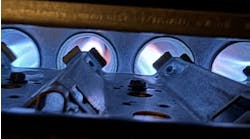Latest from Hydronics
Sponsored
As soon as the contractor said it, I knew I had to use the phrase as a title. Neither of us thought “functionality” was a word, but after the call I made his day with a texted screenshot of the Merriam-Webster definition. As you might expect: the quality or state of being functional.
We had been working on this remodeling project for a long time. First, there was the job site visit with the general contractor. I have seen some amazing views of the Ohio River as it meanders through the Cincinnati/Northern Kentucky region, but this job site might have the best.
Million Dollar View
It’s the top floor of a mansion that looks like one of the small castles at the top of the hills along the Rhine River in Germany. It even has the round turret, and from the top floor room you get a 270 degree panorama of the final meander of the Ohio River flowing towards the downtown area, the literal million dollar view.
However, the building is split into three condos that share a single steam boiler feeding cast iron radiators. The new owner of the penthouse condo wanted to modernize the radiation along with a kitchen, master bath and who knows what else. The general contractor showed us which radiators would stay and which needed to be changed.
One-Pipe System
The first thing after the shared boiler that caught my attention was the type of steam system. Generally in the bigger houses, it is a two-pipe system. However, this house was one-pipe, built pre-turn of the last century when that was popular. Steam systems are classified by the number of pipes that the steam comes in and the condensate goes out.
With a one-pipe system, the steam and condensate share the same one pipe. The connection/valve at the radiator and the piping to the radiator have to be large enough for the steam and condensate to pass each other in opposite directions. Inside the pipe, the steam travels to the radiator above the condensate traveling back to the boiler.
The pitch of both the pipe and the radiator are also very important. The new radiators would now be under the windows and up to 8 feet away from an existing radiator. Both of these conditions were making me nervous.
One of the radiators would have to be 12 foot long, which requires a minimum of ¾” pitch. The radiator manufacturer wants 1/16” per foot. The general contractor didn’t like the crooked appearance once I brought it up, so we proposed it as two radiators to bring the pitch down to 3/8”. The radiators in the photo are only 4 foot long, with a ¼” pitch. I don’t notice the pitch on those.
My other concern was the potential piping changes required for moving the radiator locations, especially the distance required, which we wouldn’t know unless the flooring was removed to find the riser locations. The general contractor said the flooring could be removed to accommodate any changes necessary. At that point I provided pricing for new panel-style steam radiators.
The Job Gets Less Complicated
The next job site visit was with the owner, general contractor, etc. We went over where all the new radiators would be located, what they would look like, what color they would be, and how much pitch to expect. There were a lot of heads nodding in agreement at that meeting.
Months later, the contractor ordered radiators for only the master bedroom. I was both disappointed and relieved. I never like to lose a good sale, but the job also got a lot less complicated. Later, when he called about the functionality thing—meaning he wanted to make sure it worked—the radiators were already hooked up. So much for checking the location of the riser in order to size and pitch the pipe that carries both the steam and condensate, moving in opposite directions.
He told me that they just went the full size of the existing, which was 1-1/2”, until it split to the two 1” radiator connections. I silently sighed in relief, thinking that 1-1/2” should be big enough, but I’ve been burned in the past, so I looked it up.
Each of the new radiators are rated at 5980 BTUs, multiplied by two gives us a total of 11,960 BTUs in total that the pipe has to carry in two directions simultaneously from the riser to the radiators. My charts are not in BUTs, but in square foot of EDR (Equivalent Direct Radiation). To get from BTUs to EDR, divide by the factor of 240. In this case we have 49.8 square feet. Let’s just round that up to 50.
The chart says that 1-1/4” pipe can carry up to 60 square feet EDR as a horizontal runout, the portion of the piping from the existing riser to the new radiator location. But wait, the note at the bottom of the chart says to use one pipe size up if the length is over 6 feet. I didn’t need to ask about the length. I could tell him that his 1-1/2” functionality thing was okay.
Valving and Control
The next call on the job was for radiator valves. On one-pipe systems, the valves have to be all the way open or all the way closed. Either on or off. But the whole building was being heated by one boiler without any zoning based on the current three condo setup. A steam cycle rate control on the boiler was determining overall building temperature, not individual thermostats.
To adjust room temperature with a one-pipe radiator system, it is much better to control the rate of air venting at the radiator rather than open and close a radiator valve. The larger the opening on the vent, the quicker it lets air out, which lets more steam in. Close the vent completely and theoretically no steam enters the radiator.
Instead of re-piping the radiators with valves, that by the chart would have to be 1-1/4”, I recommended using manually adjustable air vents on each radiator. Besides being a lot less expensive, when properly adjusted, they would keep the room at a comfortable temperature, working in tandem with the building control.
To get better control, if needed, he could put a non-electric air venting system on each radiator that adjusts the venting while sensing room temperature. Again, stay away from the radiator valves. They were from the era of coal boilers when the fires burned all day and people got out of their chairs to turn a valve on when they were cold and off when they were hot. People don’t want to do that nowadays.
Patrick Linhardt is a thirty-seven-year veteran of the wholesale side of the hydronic industry who has been designing and troubleshooting steam and hot water heating systems, pumps and controls on an almost daily basis. An educator and author, he is currently Hydronic Manager at the Corken Steel Products Co.
Patrick Linhardt
Patrick Linhardt is a forty-one-year veteran of the wholesale side of the hydronic industry who has been designing and troubleshooting steam and hot water heating systems, pumps and controls on an almost daily basis. An educator and author, he is currently Hydronic Manager at the Corken Steel Products Co.


